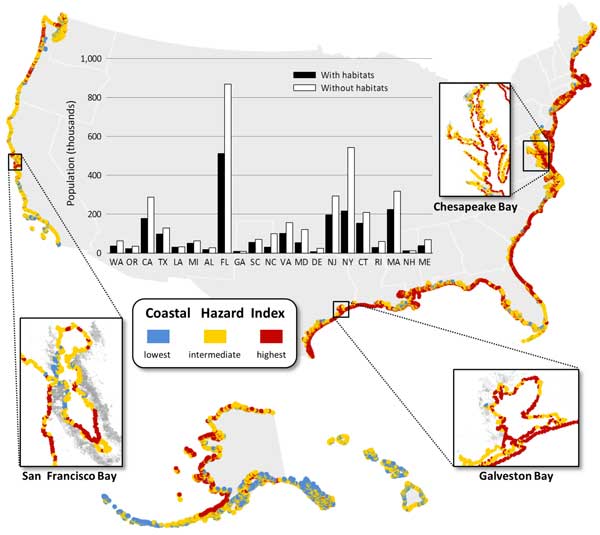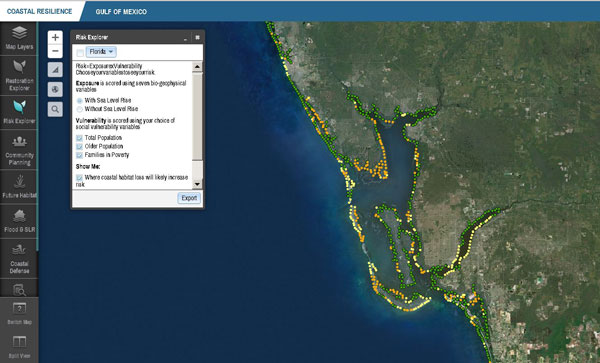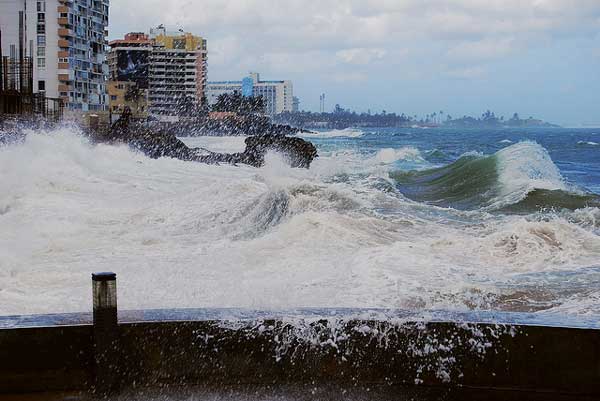Katrina, Sandy, Andrew: iconic names….and indelible examples of how nature can kill and destroy.
But could nature actually help reduce our risk from…nature? Specifically: could sand dunes, oyster and coral reefs, sea grasses and other coastal natural habitats blunt the effects of coastal storms — like surges and flooding? Could they even reduce the risk of fatalities and property loss from such storms?
They already are — for at least 1.3 million people and billions in property value along the U.S. coastline, according to a new study just published in the journal Nature Climate Change. Neglecting those habitats, the study adds, could double the number of U.S. residents at “high hazard risk” from storms — including hundreds of thousands of poor and elderly.
And with sea-level rise projected to make storm surges much worse over the coming decades, coastal nature might become even more important in reducing risk from coastal storms.
“This study shows how key a role nature plays in protecting our nation’s coasts, and it tells us where habitats matter the most for that purpose,” says Katie Arkema, the study’s lead author and a Stanford University scientist associated with the Natural Capital Project.
“If we lose these habitats, we will either have to make massive investments in engineered defenses or risk greater damage to millions of people and billions in property.”
16% of Immediate US Coastline at ‘High Hazard’ Risk; Florida, New York and California Benefit the Most from Coastal Habitats
Coauthored by scientists with the Natural Capital Project and The Nature Conservancy, the new study offers the first map of where natural habitats reduce coastal-storm risk for lives and property values along the entire U.S. coastline.
Key findings from the study:
- About 16% of the immediate U.S. coastline (within one kilometer of the shore) is classified as in “high hazard” areas—home to 1.3 million people and $300 billion in residential property;
- 67% of the U.S. coastline is protected by natural habitat — which, if lost, would double the number of poor families, elderly people and total property value in the areas at highest risk from coastal hazards such as storm surges.
- Florida, New York and California are the states where coastal habitats defend the greatest number of people (including the elderly and the poor) and the greatest amount in property values from storm risk.
- Sea-level rise will increase the amount of highly threatened people and property by 30-60% by the year 2100.

“California, Florida and New York have both a lot of people at risk from coastal storms and intact coastal and marine ecosystems that are playing a very big role in terms of reducing that risk,” says Arkema. (New Jersey and Massachusetts rank just behind those states in both categories. See Figure 1 for more details.)
“And our analysis shows that, if you were to lose or degrade habitats in these places, you’d double or almost double the number of people at risk in each state.”
‘Engineering Shouldn’t Be the Default Solution’ for Our Coastlines
The study doesn’t factor in projected population increases or continued building construction along U.S. shorelines through 2100. It also only indexes risk for that 1-kilometer sliver of shoreline, and not the millions of people inland who might be affected by extensive storm surges.
But that doesn’t diminish the relevance of the findings to coastal communities thinking about how to combat the effects of storms and sea-level rise, according to Peter Kareiva, chief scientist at The Nature Conservancy.
With 23 of the 25 most populous U.S. counties along the coast, he says the data couldn’t be more timely — especially since many planners don’t have good information on the full risk-reduction value of their natural habitats.
“Hardening our shorelines with sea walls and other costly engineering shouldn’t be the default solution,” says Kareiva. “They might be appropriate in some situations. But now we have data on those places and opportunities where nature contributes the most to protecting our coastal communities — and giving us all the other benefits it can provide, such as recreation, fish nurseries, water filtration and erosion control.”
Arkema adds that the new data could be especially useful at state and county levels — in places along the Gulf Coast; Pinellas, Hillsborough and Monroe Counties in Florida; and Kings County in New York, where reefs, vegetation and dunes play critical risk-reducing roles.
“State officials, NGOs and others can use these findings when, for example, they are making the case for how best to spend restoration funds flowing to the Gulf of Mexico after the Deepwater Horizon event,” says Arkema.
“The findings tell us which states have the most poor people at risk from coastal storms. State officials could also use the data to make targeted restoration investment decisions in the counties that are most vulnerable. And it enables them to make data-based arguments for such investments.”
The Model’s High-Risk Areas Correlate to Areas of High Fatalities from Past Storms
The analysis is built on a couple of layers of data. First, the researchers identified 9 types of coastal habitats that reduce risk, and then ranked the different levels of protection from storm effects those habitats provide — drawing on existing data about risk-reduction for well-measured habitats such as coral reefs and piecing together datasets for less-measured habitats such as eelgrass and oyster reefs. (Coral reefs and coastal forests turned out to provide the most protection.)
Then the authors mapped where those habitats occur along the whole U.S. coastline, along with variables (such as wind and wave exposure and geomorphology) that can be decisive for how much protection habitats really provide from storms.
“It’s not appropriate to quantify a habitat’s coastal protection just based on where that habitat is located — but often, ecologists and conservation biologists forget that,” says Arkema. “Big Sur in California has a ton of kelp forest, but it also has really high relief and rocky shores, so it’s not as at risk from waves causing erosion as, say, the Gulf of Mexico coastline, which is made up of low-relief, sandy shores and soft mud flats.”
Finally, using GIS analysis, the researchers located where different habitats were located in relation to each 1-km segment of coastline. If the habitat was within the distance deemed for it to provide risk reduction (“protective distance”), it was counted as providing protection.
They also created a “risk index” for the entire U.S coastline — the more people and exposure in a piece of coastline, the higher its risk index. To ground-truth the index, Arkema and her co-authors then did a hindcast with their model — comparing whether the areas that they had deemed as at “high-hazard” risk had actually suffered greater numbers of fatalities from coastal storms between 1995-2010.
The correlation between states with the most fatalities and states with “high-hazard risk” areas was excellent — as long as data about coastal habitat protection as well as exposure and geomorphology was part of the mix.
And the match got even better once data from Hurricane Sandy was included, according to Arkema. “The way to interpret that is that our model was predicting greater numbers of people exposed to hazard there then we had actually observed — until Sandy hit,” she says.
The Science We Still Need on Coastal Habitats and Risk Reduction
Despite the findings of this study, Arkema says there’s still a fair bit of science left to maximize the value of targeted habitat restoration for risk reduction.
Two specific gaps: 1) how exactly restoration needs to be deployed in specific local situations, and 2) how restoration might combine with “grey” (engineered) solutions where habitat alone isn’t possible or desirable.
“Understanding where and how we need to restore habitat or invest in its conservation is a next critical step,” she says. “Do we need more in an offshore direction or in a longshore direction, for instance, to maximize risk reduction? That’s going to vary by habitat and situation. So we need to continue building synthetic, process-based models that incorporate hydrodynamics, hurricane modeling, surge models, and economic valuation.”

Such an example is Risk Explorer, a forthcoming feature of The Nature Conservancy’s Coastal Resilience.org tool, which has incorporated some of The Nature Capital Project’s more complex process-based models to explore the effects of oyster reef placement and design on shoreline erosion rates in the Gulf of Mexico. (See screenshot above for an example incorporating that work.)
“And secondly, there are going to be places where really high value or socially important infrastructure is right on the coast, and we might not be able to have natural habitat, so we’re going to need other approaches,” Arkema says. “This analysis doesn’t compare the cost-effectiveness of multiple or hybrid green-grey approaches in those situations, and we need to do that modeling.”
Opinions expressed on Cool Green Science and in any corresponding comments are the personal opinions of the original authors and do not necessarily reflect the views of The Nature Conservancy.




Could I have a copy of the actual report, please, for an article I am wrting about coaswtl resiliency, living shorelines, oyster reefs?
Thank you
Leslie Middleton
Staff Writer
Chesapeake Bay Journal
Hi Leslie, Thank you for your interest. The report is available online, but it is behind a paywall: http://www.nature.com/nclimate/journal/v3/n10/full/nclimate1944.html I suggest contacting the corresponding author for a copy. Please let me – lfeldkamp(at)tnc.org – know if you would like to get in touch with anyone at the Nature Conservancy for more information on our work with coastal resilience.
From an English perspective, the American coast line seems to be a very (potentiality) dangerous place to be living. It was very interesting to read about the risk studies and their actual accuracy .
thanks for the interesting read Bob
Is it possible to get the full article?
Email me and I will send you a copy.
Bob, I will check on that for you concerning Risk Explorer.
I’m having difficulty finding the actual data (results from the model in GIS format or webmap) from Risk Explorer. Is it available on-line?
Bob, the Risk Explorer App will be part of a greatly enhanced package of tools in our Coastal Resilience 2.0 tool, to be released together in the first week of October. You’ll be able to see it and use it then at coastalresilience.org at that time. Apologies for the confusion.
In the current age of both increasing population density in coastal areas and concerns about climate change,environmental and water resources specialists should develop practical solutions to these challenges.